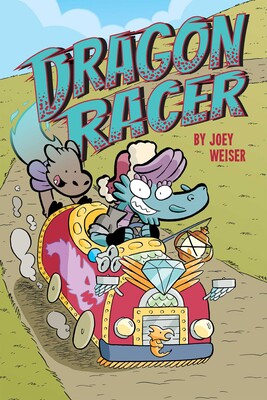Comic Book Review: Dragon Racer by Joey Weiser
Claude and Stanley are forest spirits who investigate strange goings-on in the wilder places and help set things right. A little while ago, they found a ghost hog named Truff, and helped her work through the issues that had her haunting her place of death. She no longer haunts, but is still in the mortal world, and now resides with her family. But there are reports of strange noises and a speedy unknown object on the mountain.

The mystery is solved quickly when it turns out the disturbances are caused by a young dragon named Vern. It seems that he’s one of the animals that’s been taken in by a monastery a good ways up the mountain, and there’s a pedaled vehicle race he’d dearly love to win. That’s why he’s been practicing his off-road skills in his cart, the Divine Gale. Vern is defensively boastful, but friendly, so he invites Truff, Claude and Stanley to watch the race.
It turns out Vern is not on particularly good terms with the other animal racers, as he spends more time making the Divine Gale look pretty than practical. Also, Truff is a bit shocking to the humans who run the monastery, as non-malevolent ghosts are a new idea. One child-monk, Tulip, is particularly suspicious of Truff.
The race does not go as planned, but then a crisis arises that will force Vern to both rely on his new friend, and face his own past shame.
This children’s graphic novel is a sequel to Ghost Hog by the same creator, so the opening pages may be a little confusing until the characters explain who they are.
The plotline is set up well, making it clear how the pieces fall together to create the climactic crisis. The art is cartoony and easy to follow in most places.
The society depicted might not be the best to over-analyze though. Humans run the monastery, which teaches about “all deities” and allows the disciples to find their own path, while the animals, who are all fully sentient, are more or less permanent guests who came from trouble elsewhere. All animals seen (with one key exception) are shown to be intelligent and civilized, so one wonders what the obligate carnivores eat.
And perhaps the story ties up a little too neatly, but that’s a common feature of kids’ comics.
Content note: Death is discussed, and there’s some bullying.
Overall: A nifty story that should be suitable for fourth-graders on up, and accessible to younger readers with help from a parent or guardian.

